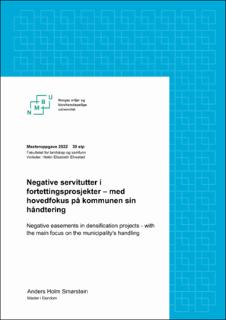| dc.contributor.advisor | Elvestad, Helén Elisabeth | |
| dc.contributor.author | Smørstein, Anders Holm | |
| dc.date.accessioned | 2022-10-19T08:52:40Z | |
| dc.date.available | 2022-10-19T08:52:40Z | |
| dc.date.issued | 2022 | |
| dc.identifier.uri | https://hdl.handle.net/11250/3026975 | |
| dc.description.abstract | Oppgaven tar for seg negative servitutter og hvordan kommunen anser disse i å sette begrensing på fortetting. Dagens lovgivning inneholder ingen bestemmelse som sier hva som skal gis forrang ved konflikt mellom de privatrettslige servituttene og de offentligrettslige arealplanene. Dette kan medføre at kommunen vedtar offentligrettslige arealplaner som strider med de privatrettslige servituttene. Oppgaven tar for seg denne problematikken, samt ser på virkemiddelet kommunen kan benytte i pbl. § 16-2 som en mulig løsning på en eventuell konflikt mellom de privatrettslige servituttene og de offentligrettslige reguleringsplanene. Samtidig vil jeg komme med noen forslag, som etter mitt syn kan bidra til å kartlegge eventuell motstrid så tidlig som i planinitiativet.
For å få en indikasjon på om dagens system generelt skaper utfordringer er det foretatt et dokumentstudium av 28 dommer. I dokumentstudiet er følgende kriterier lagt til grunn: alder, i hvilken grad kommunen har vurdert eller oppfordret initiativtaker til å vurdere servitutten sitt innhold, om det er konflikt mellom reguleringsplan og den aktuelle servitutten samt om servitutten anses som bortfalt. Som et supplement til dokumentstudiet har jeg intervjuet tre kommuner, for å få inntrykk av om kommunen anser dette som en utfordring. Samlet sett utgjør dette oppgavens empiriske grunnlag. Aktuelle lovbestemmelser, forarbeider, rettspraksis samt juridisk litteratur danner grunnlaget for oppgavens teoretiske grunnlag.
Gjennom drøftelsen av det empiriske og teoretiske materialet har jeg kommet frem til at kommunen ikke anser dette som en utfordring som setter begrensing på fortetting. Kommunen ønsker å stå fritt i planleggingen av hva kommunen sine arealer skal brukes til. Det er ikke ønskelig fra kommunen sitt ståsted at eldre servitutter skal være styrende for kommunen sin planlegging. Derav ekspropriere kommunen svært sjeldent en servitutt til fordel for reguleringsplan jf. pbl. § 16-2, noe som også understrekes av det aktuelle dokumentstudiet. For at kommunen skal benytte hjemmelen i pbl. § 16-2 må kommune ha en «interesse i utviklingen» av det aktuelle prosjektet, samt at det må være et prosjekt som anses som et «samfunnsnyttige tiltak». | en_US |
| dc.description.abstract | The thesis deals with negative easements and how the municipality considers these in setting a limit on densification. Current legislation does not contain any provision that states what is to take precedence in the event of a conflict between the easements under private law and the area plans for public law. This may lead to the municipality adopting public law area plans that conflict with the private law easements. The thesis addresses this issue, and looks at the tool the municipality can use in the Plan and building Act §16-2 as a possible solution to a possible conflict between the private law easements and the public law zoning plans. At the same time, I will make some proposals, which in my view may can help to map any contradictions as early as in the planning initiative.
In order to get an indication of whether the current system generally creates challenges, a document study of 28 rulings has been carried out. The document study is based on the following criteria: age, the extent to which the municipality has assessed or encouraged the initiator to assess the easement's content, whether there is a conflict between the zoning plan and the easement in question and whether the easement is considered lapsed. As a supplement to the document study, I have interviewed three municipalities, to get an impression of whether the municipality considers this a challenge. Overall, this constitutes the empirical basis of the thesis. Relevant legal provisions, preparatory work, case law and legal theory form the basis for the thesis' theoretical basis.
Through the discussion of the empirical and theoretical material, I have come to the conclusion that the municipality does not consider this as a challenge that places a limit on densification. The municipality wants to be free in the planning of what the municipality's areas will be used for. It is not desirable from the municipality's point of view that older easements should govern the municipality's planning. As a result, the municipality very rarely expropriates an easement in favor of a zoning plan, in the Plan and building Act § 16- 2, which is also emphasized by the relevant document study. In order for the municipality as a whole to use the legal basis in the Plan and building Act § 16-2, the municipality must have an "interest in the development" of the project in question, and that it must be a project that is considered a "socially beneficial measure". | en_US |
| dc.language.iso | nob | en_US |
| dc.publisher | Norwegian University of Life Sciences, Ås | en_US |
| dc.rights | Attribution-NonCommercial-NoDerivatives 4.0 Internasjonal | * |
| dc.rights.uri | http://creativecommons.org/licenses/by-nc-nd/4.0/deed.no | * |
| dc.title | Negative servitutter i fortettingsprosjekter : med hovedfokus på kommunen sin håndtering | en_US |
| dc.title.alternative | Negative easements in densification projects : with the main focus on the municipality's handling | en_US |
| dc.type | Master thesis | en_US |
| dc.description.localcode | M-EIE | en_US |

